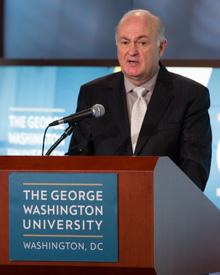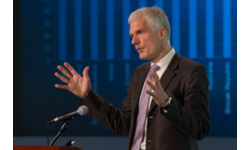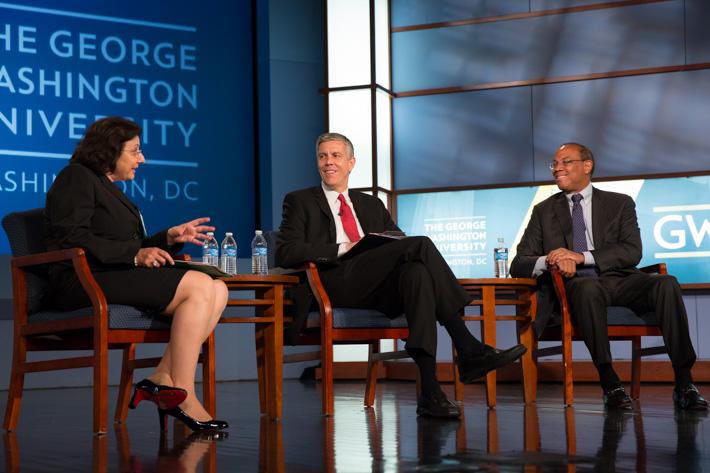A report by the Organisation for Economic Co-Operation and Development (OECD) Programme for International Student Assessment (PISA) released on Wednesday found that U.S. students exhibit an average knowledge of financial literacy compared with 29,000 15-year-old students around the world.
According to U.S. Secretary of Education Arne Duncan, average isn’t good enough.
“The sobering news here is that we are basically average, and we in America have to aspire to be better than that,” Mr. Duncan said. “The good news is that doing well in financial literacy and doing well in math have been inextricably linked. The fact that the vast majority of states are raising math standards gives me great optimism.”
Mr. Duncan and John W. Rogers, chair of the President’s Advisory Council on Financial Capability for Young Americans, discussed the findings at the Jack Morton Auditorium with Annamaria Lusardi, director of the Global Financial Literacy Excellence Center (GFLEC) at the George Washington University School of Business.
Dr. Lusardi, chair of the OECD experts group that designed the financial literacy assessment, said that GFLEC was proud to collaborate with OECD.
“Financial literacy is critically important for young people.” Dr. Lusardi said. “While still in high school, students face life-changing decisions, most notably about whether to continue their education and how to pay for it if they do.”

GW President Steven Knapp
GW President Steven Knapp welcomed policy experts, government officials, educators and students to the program hosted by GFLEC in collaboration with the U.S. Department of the Treasury, the U.S. Department of Education and the Consumer Financial Protection Bureau.
The conference, sponsored by PwC, McGraw Hill Financial and the Council for Economic Education, marked the U.S. release of the data gathered in 2012—the first large-scale international evaluation of financial literacy among youth.
The study tested students in 18 countries on their ability to assess financial data and solve problems using basic financial concepts. The report, “Students and Money- Financial Literacy Skills for the 21st Century,” analyzed student performance based on location and economic, social and educational factors.
Another PISA assessment is planned for 2015.
The U.S. had a mean score of 492, just below the total mean of 500. Nine percent of American students exhibited high proficiency compared with 43 percent of students in China, specifically Shanghai— the highest scoring group of students.
Eighty percent of U.S. students were unable to properly analyze a basic invoice.
Andreas Schleicher, director of the OECD Directorate for Education and Skills, presented the data, following an introduction by Carrie Schwab-Pomerantz, M.B.A. ’87, president of the Charles Schwab Foundation.
Dr. Schleicher said that U.S. students were severely outpaced by students in top performing countries due to a lack of understanding of the mathematical concepts that underpin financial literacy.
Dr. Schleicher also said that a combination of exposure to financial issues outside of school and an understanding of intellectually rigorous mathematical concepts are integral to strengthening financial literacy among American students.

"The knowledge economy doesn’t reward you for what you know, it rewards you for what you can do with what you know,”
- Andreas Schleicher, director of the OECD Directorate for Education and Skills
The mathematical curriculum in the U.S. focused heavily on trigonometry because that was how people measured their fields,” Dr. Schleicher said. “Now probability and statistics are the ingredients of financial literacy. The curriculum in the U.S. has not adjusted to the changing world.”
Mr. Duncan echoed Dr. Schleicher’s call for improving educational standards but acknowledged that it is a tough political sell.
He said that as states, such as Tennessee, have voluntarily raised curriculum standards, the student achievement gap for mathematics has dramatically increased. The numbers may not look good on paper, but they indicate how students are being challenged in the classroom, he said.
“For young people to be successful, to be able to retire, to not be in poverty and to be able to take care of their family, they will need a level of financial literacy that wasn’t required 20 years ago,” Mr. Duncan said.
Mr. Rogers, CEO and chairman of Ariel Investments LLC, the largest minority-owned mutual fund firm, said that working with students at a young age, focusing on underserved communities and involving parents and teachers will increase financial literacy and ease the financial inequality that exists in the U.S., which will strengthen the economy in the long run.
“If we do this well and we do it right, you’re going to have more successful entrepreneurs,” Mr. Rogers said.
According to Dr. Schleicher, progress will be dependent on the U.S.’s ability to address the quality of education around financial literacy rather than the quantity of education—so that students can act responsibly.
“The knowledge economy doesn’t reward you for what you know, it rewards you for what you can do with what you know,” Dr. Schleicher said.
Dr. Lusardi agreed.
“Teaching the fundamentals of financial literacy will benefit the economic future of our students and the nation,” Dr. Lusardi said.


